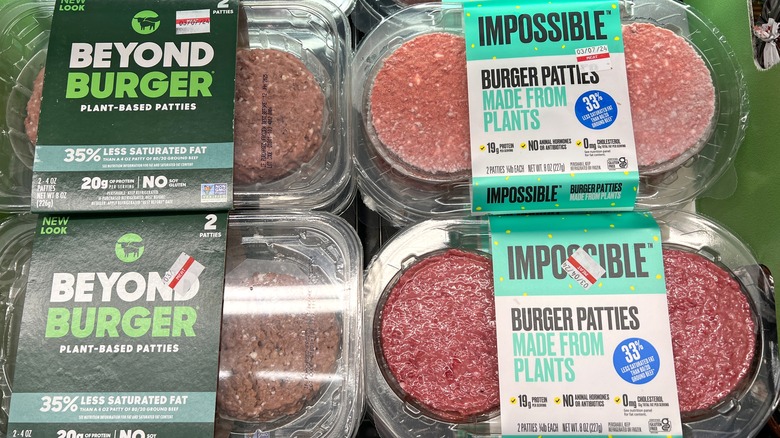What Should The Internal Temperature For Cooked Plant-Based Meat Be?
Food safety is arguably the most important part of cooking. Several food safety mistakes could end up being dangerous, including the improper handling, storage, and preparation of meat. Cooking to a safe internal temperature is necessary to prevent food poisoning, and guidelines — such as making sure poultry hits a temperature of 165 Fahrenheit — are well-known and well-documented. We often hear about tips for cooking traditional meat to the perfect temperature, but what about plant-based meats?
Although it might seem logical that plant-based foods don't come with the same safety concerns as meat sourced from animals, studies suggest that they should be handled with the same precautions. That means taking care to not keep raw, plant-based meats at room temperature, properly thawing in the refrigerator, and hitting a target internal temperature.
Anna Porto-Fett is a microbiologist at the Agricultural Research Service's Eastern Regional Research Center. She explained (via the USDA), "Plants often harbor high levels of foodborne pathogens and, as such, plant-based burgers should be considered and handled just like, for example, raw ground beef." Still, the relatively new emergence of plant-based meats means that guidelines might be a little harder to come by, so let's look at the advice on how to keep safe when cooking up your favorite plant-based burger.
Plant-based meats need to be cooked to the same temperature as traditional meat
A 2020 study published by the International Association for Food Protection revealed some eye-opening stuff. It looked at plant-based meats and the likelihood they could carry the foodborne pathogens E. coli, listeria, and salmonella. In a nutshell, it confirmed that the bacteria could not only survive in plant-based meats but thrive — especially when they weren't properly refrigerated. That said, it also found that when plant-based burgers were properly cooked, the threat of food poisoning was lessened in the same way it was in beef burgers.
When it comes to proper temperature, here's where things get tricky. The study suggested that foodborne pathogens started to die when the internal temperature of the beef or plant-based meats reached 145 degrees Fahrenheit. But Anna Porto-Fett explained that this was only the beginning of its findings. To make sure plant-based meat alternatives are safe for consumption, she explained that the target number was actually 160 degrees Fahrenheit. She told the USDA, "If you follow the 'Four C's of Food Safety,' which are Cook (160 degrees Fahrenheit), Clean, don't Cross-contaminate, and Chill, you can appreciably lower — but not eliminate — your risk of foodborne illness."
What risks make temperature guidelines so important?
It might seem surprising that plant-based meats present some of the same dangers as traditional meats. According to Food Safety News, experts stress that plant-based meats are processed, so there's still the potential for contaminants. Crops used in the manufacture of plant-based foods might be exposed to pathogenic microorganisms — like bacteria, mycotoxins, and viruses — through the soil or by coming into contact with animals. A study cited by Food Safety Magazine also found that because plant-based meats are high-protein, high-moisture environments with no acidic properties, they're ideal for hosting microorganisms — especially as they approach their expiration date.
Interestingly, the biggest danger is the consumer. That's according to Michigan State University food safety educator Mary Donaldson, who says, "Consumers often don't consider that food from plants can also pose a risk of foodborne illnesses if not properly handled ... Although many of the hazards for meat and plant-based protein meat substitutes are different, handling them properly is the same." That includes cooking to an internal temperature of 160 degrees Fahrenheit, keeping raw plant-based protein away from ready-to-eat foods, thoroughly washing hands and surfaces, and properly refrigerating and freezing cooked and uncooked foods. Although some cooking processes might be different — for instance, there's a difference in marinating plant-based meats as opposed to traditional meat — a good rule of thumb is to treat plant-based meats with the same food safety rules that apply to traditional meats.


